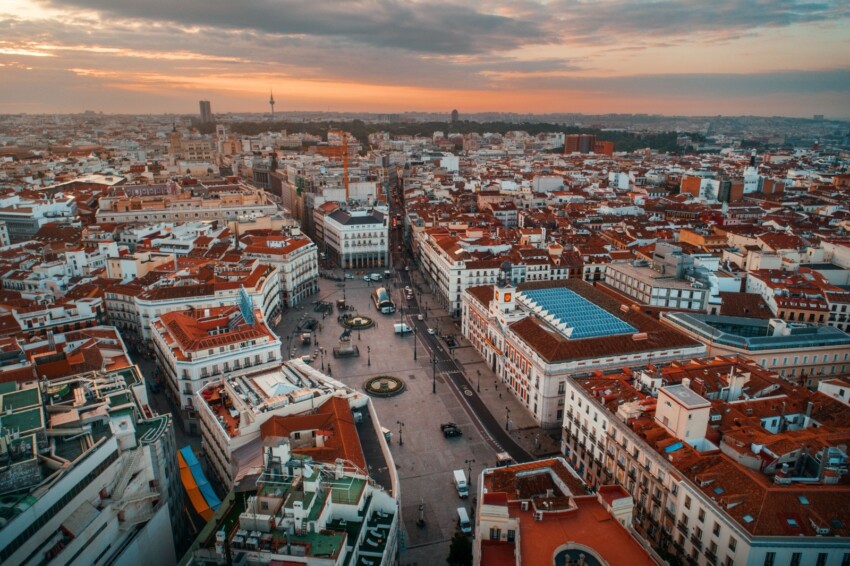

Once the eastern gateway to the city, today Puerta del Sol is the nerve centre of Madrid and symbolically of the whole of Spain. On this semicircular square, one of the largest and most famous in the capital, the city’s main thoroughfares converge (Calle Mayor, Arenal, Alcalá or Preciados); three metro lines stop at the Sol station and numerous buses depart and arrive.
Puerta del Sol can be said to be as old as Madrid: it was built in the 15th century at the same time as the foundation of the new Spanish capital to replace Toledo.
It soon became an important commercial, administrative and cultural centre of the city. Numerous interventions over the centuries changed its appearance to what we can still admire today between 1857 and 1862, with the work of architects Lucio del Valle, Juan Rivera and José Morer.
A transit hub for hundreds of Madrileños who pass through here every day on their way to other places, Puerta del Sol square occupies an important place in the hearts of all Spaniards because of its symbolic location in the centre of the country and because some of the most representative buildings and elements of Madrid are concentrated here.
The site of numerous historical events, including the proclamation of the Second Republic in 1931, the square is now the location of festive occasions such as cultural and sporting events (the Challenge Madrid triathlon competition passes through here), but the best occasion to admire the square at the height of its festive mood is 31 December.
Puerta del Sol is where the citizens of Madrid gather for the New Year’s Eve celebrations. In an atmosphere of collective euphoria, they welcome in the New Year with an auspicious tradition that has been televised and broadcast live to families all over the country since 1962.
Puerta del Sol Square is lined with elegant buildings from various eras. Casa de Correos stands out, so called because it was once the headquarters of the Post Office; today it houses the administrative offices of the Community of Madrid.
The clock of Casa de Correos is a real ‘celebrity’ in Spain: it is in fact this ancient clock that marks the twelve chimes that mark the stroke of midnight on New Year’s Eve. Tradition has it that a grape is eaten at each chime, one for each month to come, as an auspicious rite for the New Year.

The most photographed tourist attraction in Puerta del Sol square is curiously enough a small plaque on the floor that if it had not become so famous you could walk on without even noticing it.
Instead, it will be impossible for you not to notice it because crowds of visitors, mostly Spaniards, gather around, desperate to see this ‘monument’ among the most famous in Madrid.
The reason why this plaque has become famous is because it marks kilometre 0 of the Spanish motorway network, i.e. the point from which the measurement of the different national roads that radiate from Madrid to the most diverse points of the country begins.

Another famous attraction in Puerta del Sol is ‘el oso y el madroño’, the statue of the bear and the arbutus, an image that takes up the city’s coat of arms; it symbolically represents fertility (the tree) and the city’s aristocracy (the bear). Built in 1967, the statue is now a popular meeting place for many Madrileños.
The fountain in the centre of the square is dominated by the equestrian statue of King Carlos III, an enlightened monarch who, during his reign from 1759 to 1788, promoted numerous reforms aimed at modernising society and the structure of the state.
The statue you can admire on the side where Calle Arenal begins, the Mariblanca statue, is a replica of the 17th century original.

How many advertisements become tourist attractions? In Puerta del Sol, the Tio Pepe sherry advertising sign has dominated the square with its neon lights for so many years that it has now become an indispensable element of Madrid’s urban landscape.
Puerta del Sol is centrally located in the Sol/Gran Vía area and can be easily reached by metro and bus. But above all, it can be reached on foot if you are already in the city centre: in some ways it represents the very centre of Madrid, so it is only natural that around this square there are plenty of establishments where to stay, both in the square itself and in the immediate vicinity. Small and large hotels, flats and bed and breakfasts: the choice is almost endless.
Technically, the Puerta del Sol is located in the exact centre of Madrid, as it is from here that the city's distance from the rest of Spain is measured. From a broader point of view, it is located between Calle Mayor and Calle de Alcalà, just south of Gran Via.
City Card allow you to save on public transport and / or on the entrances to the main tourist attractions.
